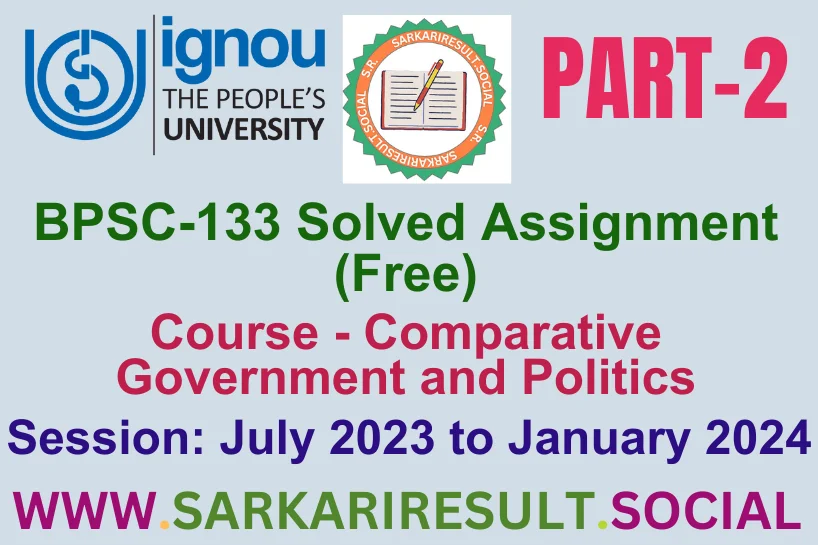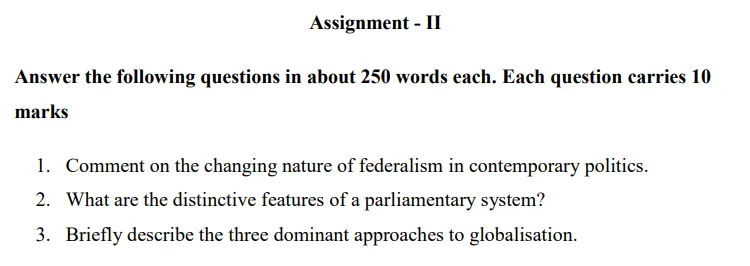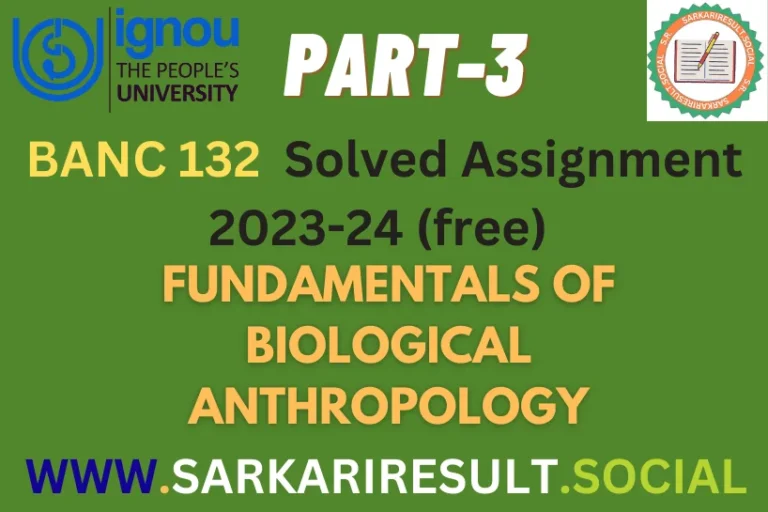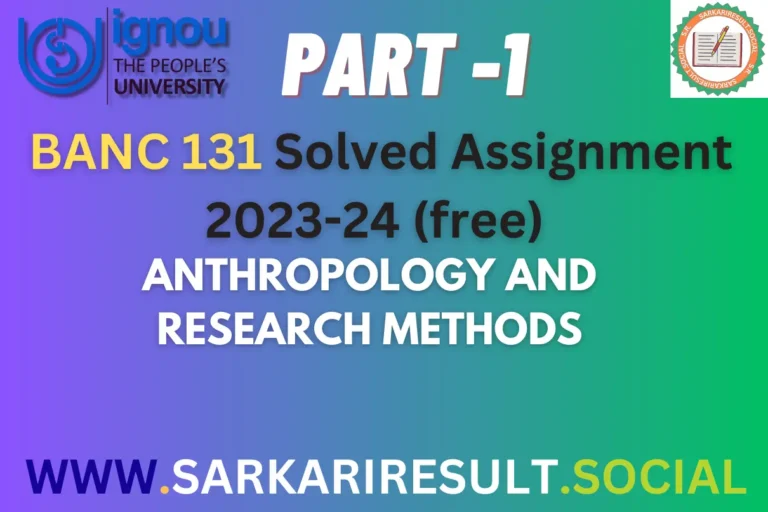BPSC 133 SOLVED IGNOU ASSIGNMENT FREE PART 2

Welcome to the BPSC 133 SOLVED IGNOU ASSIGNMENT FREE PART 2 TMA. Assignment – II streamlines your approach with concise answers to three pivotal questions. In about 250 words each, comment on the changing nature of federalism in contemporary politics, outline the distinctive features of a parliamentary system, and provide a brief description of the three dominant approaches to globalization. Our short and focused responses offer a straightforward path for grasping these critical aspects of comparative government and politics, ensuring a smooth and successful completion of your assignments.

Answer the following questions in about 250 words each. Each question carries 10 marks
Q.1 Comment on the changing nature of federalism in contemporary politics.
Ans. The nature of federalism, which defines the distribution of powers between a central government and subnational entities, has undergone significant changes in contemporary politics. Several trends highlight the evolving dynamics of federal systems worldwide:
1. Devolution of Powers:
– There is a growing trend towards devolving powers from the central government to regional or local authorities. This devolution aims to enhance local governance, address regional disparities, and accommodate diverse cultural and linguistic identities.
2. Globalization Impact:
– Globalization has altered the traditional functions of states. Issues such as trade, environment, and security often require collaborative efforts, leading to a reevaluation of federal power dynamics. International organizations and agreements play a more substantial role in shaping policy.
3. Flexibility in Federal Structures:
– Federal systems are adapting to be more flexible, allowing for greater responsiveness to regional needs. Some countries are experimenting with asymmetrical federalism, tailoring powers and responsibilities to specific regions based on unique circumstances.
4. Shift in Fiscal Federalism:
– There is a reconsideration of fiscal federalism with an emphasis on revenue-sharing mechanisms. Regions often seek greater control over their finances to address local priorities, leading to discussions on taxation powers and revenue allocation.
5. Role of Subnational Entities in Global Governance:
– Subnational entities, especially in federal systems, are increasingly engaging in global governance. Cities and regions are forming direct partnerships and networks, bypassing national governments, to address shared challenges like climate change and urbanization.
6. Challenges to Federalism:
– Federalism faces challenges from populist movements that advocate for centralized power. In some cases, there is a pushback against regional autonomy, driven by nationalist sentiments.
7. Technological Advances:
– The digital era has altered the dynamics of federalism by enabling more direct communication between citizens and governments at different levels. This challenges traditional hierarchies and empowers local entities.
8. Crisis Response:
– Federal systems are tested in times of crises such as pandemics or economic downturns. The efficiency and effectiveness of responses influence the perception of federalism’s efficacy.
In conclusion, the changing nature of federalism reflects a global reevaluation of governance structures to address contemporary challenges. The evolving dynamics emphasize flexibility, collaboration, and adaptability, as federal systems strive to balance the needs of local autonomy with the imperatives of global interconnectedness.
Q.2 What are the distinctive features of a parliamentary system?
Ans. A parliamentary system of government is characterized by several distinctive features that differentiate it from other forms of governance. Here are key features of a parliamentary system:
1. Fusion of Powers:
– In a parliamentary system, the executive (headed by the Prime Minister) is drawn from the legislature (Parliament). This fusion of powers contrasts with a presidential system, where the executive is elected separately.
2. Role of the Head of State and Head of Government:
– The head of state and head of government are usually separate entities. The head of state (e.g., monarch or president) often has a ceremonial role, while the head of government (e.g., Prime Minister) is the leader of the ruling party and holds executive powers.
3. Collective Responsibility:
– The executive is collectively responsible to the legislature, particularly the lower house. If the government loses a vote of confidence, it may lead to its resignation and possibly the dissolution of the parliament.
4. Role of the Prime Minister:
– The Prime Minister is the chief executive and the leader of the majority party in the lower house. The Prime Minister is responsible for policy formulation and administration.
5. Flexible Elections:
– Elections can be called before the completion of the fixed term if the government loses a vote of confidence. This flexibility contrasts with fixed-term elections in presidential systems.
6. No Fixed Term for the Executive:
– The executive’s term is not fixed; it depends on the confidence of the majority in the legislature. A change in government can occur mid-term through a vote of no confidence.
7. Question Time:
– Regular sessions, such as Question Time, allow members of the legislature to question the executive, enhancing accountability.
8. Cabinet System:
– The executive’s power is exercised through a Cabinet, a group of ministers chosen from the parliament. Cabinet decisions are collective, ensuring a collaborative approach to governance.
9. Lack of Separation of Powers:
– Unlike presidential systems, there is a lesser degree of separation of powers between the executive and legislative branches. Ministers are drawn from the parliament and are accountable to it.
10. Ease of Government Change:
– In the event of a vote of no confidence, a new government can be formed quickly without the need for separate elections.
11. Coalition Governments:
– Coalition governments are common in parliamentary systems, where parties join together to form a majority. This can lead to more diverse representation but may also require negotiation and compromise.
In summary, a parliamentary system is characterized by the integration of executive and legislative powers, collective responsibility, and the centrality of the Prime Minister in the governance structure. These features contribute to the agility and adaptability of parliamentary systems in responding to changing political dynamics.
Q.3 Briefly describe the three dominant approaches to globalisation.
Ans. Three dominant approaches to globalization provide distinct perspectives on its nature, impact, and consequences. These approaches offer varied insights into the complex phenomenon of globalization:
1. Hyperglobalist Approach:
– The hyperglobalist perspective sees globalization as an unprecedented and all-encompassing force. It emphasizes the breaking down of national barriers, the rise of a global culture, and the dominance of supranational institutions. Proponents argue that economic globalization is eroding the significance of nation-states, leading to a borderless world. However, critics argue that this view may oversimplify the complexities of globalization.
2. Skeptical Approach:
– The skeptical approach adopts a more cautious stance toward the transformative power of globalization. It recognizes the intensification of global interconnectedness but questions the extent of its influence on national sovereignty and the erosion of state authority. Skeptics argue that while economic integration has increased, political and cultural domains remain significantly influenced by national considerations. They contend that globalization may not be as all-encompassing as hyperglobalists suggest.
3. Transformationalist Approach:
– The transformationalist perspective seeks to strike a balance between hyperglobalism and skepticism. It acknowledges the profound changes associated with globalization but emphasizes the variability of its impact across different sectors and regions. This approach recognizes that globalization is a complex and multifaceted process that does not uniformly affect all aspects of society. It considers the role of both global and local factors in shaping the outcomes of globalization.
In summary, the hyperglobalist approach sees globalization as an overwhelming force diminishing the significance of nation-states, the skeptical approach questions the extent of its influence, and the transformationalist approach recognizes the complexity and variability of globalization’s impact. Each perspective offers valuable insights, contributing to a more nuanced understanding of the multifaceted phenomenon that is globalization.
Also See This: BPSC 133 SOLVED IGNOU ASSIGNMENT FREE PART 3







